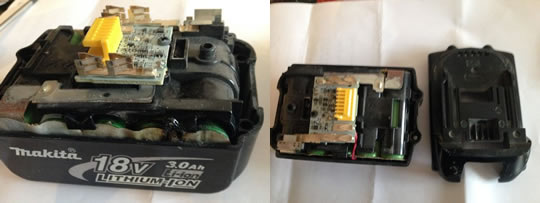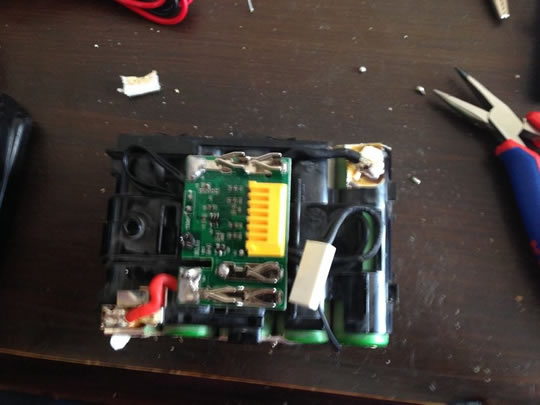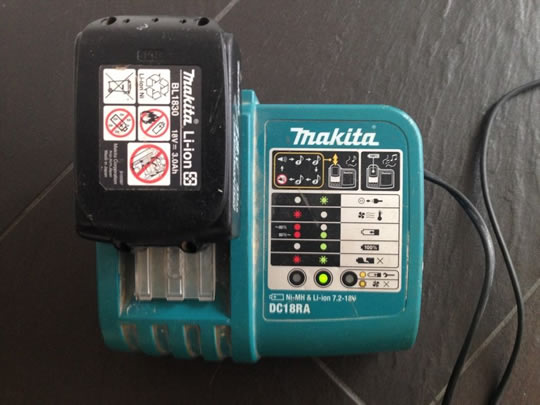Makita 18V BL1830 Lithium-ion Battery Repair
I have been a big fan of the Makita 18v LXT cordless tools for several years now. In most cases I rarely if ever use the corded tools they replaced, despite this there does seem to be a major week point, the batteries. Out of the eight batteries I have purchased over the years four have failed out side of the warranty period, plus two failed within or just after the end of the warranty and were replaced at no charge by Makita.
It seems there are two main failure causes, number one over heating and the second is the first two cells fail due to them being used to power the battery management chip and slowly discharging over an extended idol period. This causes the battery to be unbalanced. Once you get the red / green flashing lights three times on the charger your battery control board locks the battery from being recharge again.
I will be concentrating on replacing the battery control board as frequently this is all you need to do to get things up and running, although if you do require new cells these can be changed pretty easily. Makita seem to use the Sony Konion LiMn cells and these are available online for between fire and ten pounds each or you can frequently pick up failed batteries on ebay and cannibalise these for parts. If you do need to replace cells spot welding to the cells is the best way to go, as if you solder you risk overheating. Battery tab spot welders do come up on ebay from time to time or its something an electronics hobbyist could make themselves.

Before we start with the dismantling, remember that even if your batteries do not work anymore they most likely still contain a significant amount of energy. Be careful in how you handle them and above all make sure you do not short them out.
So the first step is to get the cover off. This is held on by four T10 Anti Tamper screws, on newer models there may be a white Anti Tamper plug covering one of the screws. I have found that the easiest way to remove it is to drive in a small wood screw and pull it out with a pair of pliers. Once you have the battery open being careful that the retaining clip spring does not fly away or short out the control board you should be able to see if there are any obvious major issues. The first time I open one of these batteries up I was surprised how much dust had made its way into the Makita cordless power tool batteries, I soon learned to keep my charger away from dust and never to charge them on the floor!
If on opening you seen any visibly damaged cells you are going to have to replace them which is outside of the scope of this write up.
Testing the Batteries
I had four failed batteries, and checked the voltages of the batteries and cell pairs individually. I found the following:
- Battery One: Fails to charge with a over temperature alert. Also the plastic at the side of the release button has bubbled. It is showing 7.99v across the whole battery which is way to low and 0.04v, 0v, 3.96v, 0.04v and 3.97v across each of the cell pairs respectively. Upon opening up the battery there is obvious damage to the second pair of cells.
- Battery Two: Fails to charge with classic red / green flashing lights. It is 12.84v across the battery and 3.2v, 0v, 3.22v, 3.22v & 3.21v across each of the cell pairs respectively.
- Battery Three: Fails to charge with classic red / green flashing lights. It is 15.54v across the battery and 0v, 3.89v, 3.89v, 3.89v & 3.89v across each of the cell pairs respectively.
- Battery Four: Fails to charge with classic red / green flashing lights. It is 18.15v across the battery and 3.62v, 3.63v,3.6, 3.63 &3.62v across each of the cell pairs respectively.
By way of comparison a known good battery seems to measure around 20v when freshly charged.
So I decided that my best option to end up with an extra working battery was to change the board on Battery Four as its cells were all pretty close on voltage suggesting it was fairly evenly charged. Up until recently replacement circuit board were not available so once you had seen the red / green flashing lights three times your battery was bricked. However recently they have become available for a round £10 which is certainly much cheaper than a replacement 3.0Ah Makita 18V LXT battery.
Fixing the other batteries is going to be a little more challenging. Whist it is possible to solder cells together the heat required to solder them risks damaging the cells. Having investigated purchasing a battery tab spot welder I feel that is out of my budget but I may have a go at making a capacitor discharge one.
Replacing the Control Board

The control board came with ok instructions on how to fit but they don't explain everything, this may be because it can be used with all of the models of 18v LXT battery Makita have made. Providing you have a bit of common sense you should be ok.
So apart from the soldering you might expect you also have to cut away a lot plastic and that's assuming you are lucky like me and don't need to replace any cells. If you do spot welding to the cells is the best way to go, as if you solder you risk overheating. As I had previously got the 4.0A Maita 18V LXT battery pack out of the case the first thing to do was remove the existing pcb and cut away the plastic pcb support etc as per the instruction. I opted to cut the nickel contacts instead of desoldering. Fitting the pcb and soldering the wires to the contacts was simple although I had to break out my larger soldering iron. By far the hardest part was getting the covers back on this took a little fettling of the plastic to get it to fit.
Putting It to charger Test

Next came the moment of truth, I put the battery on a charger and it charged. I then fully discharged the 5.0Ah Makita 18V LXT battery and once again recharged the battery and that also worked. Eight month on the battery is still preforming perfectly.